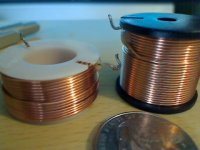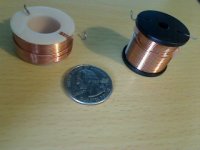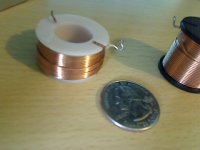Deciding between a high quality Goertz 1.20 mH air core copper foil 12 AWG inductor, and an Erse Super Q iron core copper 12AWG inductor for a series mid-woofer application. The DCR for the air core is 0.141 and for the iron core about 0.05. The speaker will be supported by an 80 watt / channel OTL tube amp. The iron core inductor is rated for 500 watts, but have reportedly been tested at up to 1000 watts with no core saturation. A general rule seems to be, always go air core and foil if possible. Prices of each are comparable.
Question. Will the air core sound better than the iron core? Which would you choose?
Question. Will the air core sound better than the iron core? Which would you choose?
Foil inductors are considered a waste of money, period. Solid core inductors are usually recommended for inductances higher than 2-3 mH and in high power applications, usually in bass circuits for 3-way or subwoofer systems. The only thing to consider is DCR and how it will affect the rest of the system.
IMHO in your particular application go with standard air core and save your money. That would be my choice and you won't hear any difference.
IMHO in your particular application go with standard air core and save your money. That would be my choice and you won't hear any difference.
sdclc126 said:Foil inductors are considered a waste of money, period. Solid core inductors are usually recommended for inductances higher than 2-3 mH and in high power applications, usually in bass circuits for 3-way or subwoofer systems. The only thing to consider is DCR and how it will affect the rest of the system.
IMHO in your particular application go with standard air core and save your money. That would be my choice and you won't hear any difference.
Sorry - but I disagree (to some extent).
1st: Air cores vs. solid cores..
Air cores do not exhibit core hysteresis unlike virtually all core-based inductors. Core hysteresis changes the sound, and usually for the worse. (Note you might be able to avoid this issue with an amorphous core.) Air cores do however have higher resistance for a given inductance (than their core-based alternatives). Higher resistance can alter the sound, particularly when its fairly high (relative to the average for the load - i.e. 10 percent of the nominal load or more). Resistance can of coarse increase from an increase in temp. - and in any given loudspeaker *could* be a moving "target". (note however that a driver's VC is far more likely to be a problem thermally than virtually any moderate gauge *added* inductor.. but not any resistor.) Best "bet" here is to use higher gauge wire ..or a multi-strand wire that equates to a higher gauge wire (if you "fear" skin effect).
2nd: Foil vs. std. wire..
Foil can be wound to resonate (mechanically) *differently* than std. wire. I'd venture that most audible differences (if any) between a similar inductor (gauge, conductor, core - if any), are mechanically induced. Furthermore, I also personally find it increasingly difficult to notice a difference between foil vs. std. wire as driver efficiency decreases and as more components are added to a crossover. (..and no, I have no idea why that is.) Which do I prefer (when I can here the difference)? - The foil version (at least in air core - though likely with a solid core as well).
Bottom line: I'd pick the Goertz inductor at 1.2 mH (..and have done so on many occasions - provided their inductance values have what I need).
Magura said:This is what keeps the snake oil buisness running
Magura
Whenever I research something, and can't find any objective arguments to support it, that is what I conclude.
shlijb - zalytron.com has great prices on 14 awg air core inductors. The 1.20 mH has an RE of .243, and a price of $13.06 per inductor. Only down side is the $50 minimum order, and paying by paypal.
Dan
Best bet is to buy both and a cheap standard air core. Do a listening test with all 3.
Even if there isn't a difference, you could probably convince yourself that there is.
The results of the test could be reported back here, and it would justify using the favourite descriptive words such as "transparent" or "strident" or "veiled".
Good luck.
Even if there isn't a difference, you could probably convince yourself that there is.
The results of the test could be reported back here, and it would justify using the favourite descriptive words such as "transparent" or "strident" or "veiled".
Good luck.
MJL21193 said:Best bet is to buy both and a cheap standard air core. Do a listening test with all 3.
Even if there isn't a difference, you could probably convince yourself that there is.
The results of the test could be reported back here, and it would justify using the favourite descriptive words such as "transparent" or "strident" or "veiled".
Good luck.
Mmm...
Indeed such a listening test would reveal what the audible differences of those exact three coils would have in that exact application.
However, I suspect that the audible effects, if any, would depend largely on the DC resistance of the coils. This resistance can and should be considered when designing a crossover filter, and if it differs between coils, the one that is mismatched will sound "worse".
In other words, the test will not tell anything about if solid core or air core coils is better.
To make the test say anything about other things than DCR, a small resistor should be added to the coil with the lowest resistance to even out the obvious differences. If there still is an audible difference (in a blind test with prober significance blabla) it can probably be explained by core nonlinearities or whatever mechanical vibrations.
My guess is that the foil and wire coil will come out identical, and that possibly the iron core coil is audibly different. Possibly.
Svante said:
Mmm...
Indeed such a listening test would reveal what the audible differences of those exact three coils would have in that exact application.
However, I suspect that the audible effects, if any, would depend largely on the DC resistance of the coils. This resistance can and should be considered when designing a crossover filter, and if it differs between coils, the one that is mismatched will sound "worse".
In other words, the test will not tell anything about if solid core or air core coils is better.
To make the test say anything about other things than DCR, a small resistor should be added to the coil with the lowest resistance to even out the obvious differences. If there still is an audible difference (in a blind test with prober significance blabla) it can probably be explained by core nonlinearities or whatever mechanical vibrations.
My guess is that the foil and wire coil will come out identical, and that possibly the iron core coil is audibly different. Possibly.
Things that make you go mmmm..
Resistance mismatch.. depends on how much for a given application.
I done this with varying wide bandwidth drivers in a different applications. Some were eff., and some were not. In each case though it was always connected for a lowpass character (in series).
The solid core vs. air core test did nothing more than show a preference for the air core (be it foil or std. wire) .. and it wasn't a matter of preferring more resistance. Additionally, the add-a-resistor-to-solid core doesn't work out as expected.. it actually sounds worse with a *common* resistor (as I've found it does when adding any common resistor).
To "stir the pot" some more, I'll add on other item that might be of interest to some:
IF you have a passive design, and
IF you have a low-passed low freq. driver unit that requires large inductors, then
You are likely better off with a good (design and parts) *series* crossover.
umut1001 said:hi..i have 0,5mh air core inductors..my multimeter is broken and i dont know how much resistance they have..do you have an idea..it has about 3cm radius and 3cm height..thanks
The guess would be about .4 ohms, but is highly dependent upon wire gauge.
http://cgi.ebay.com/Copper-Foil-Air...289444519&_trksid=p3286.c0.m14&_trkparms=66:2|65%3A15|39%3A1|240%3A1318
its same but i have 0.5 mh inductor..i think its 0.075ohm..its very low isnt it ?
its same but i have 0.5 mh inductor..i think its 0.075ohm..its very low isnt it ?
From what I've read, the laminated steel core inductors tend to have the least distortion of the saturable core types.
I generally like the foil types, but the insulating tape dielectric properties become more important than for round wire types. I once did an xover with early Solo inductors using mylar instead of polypropylene tape and replaced them later with Goertz types because of the improved (less harsh) sonic properties of polypropylene.
Foil type inductors generally have two advantages over round wire types: less skin effect, meaning the inductance is more constant to higher frequencies (more important for HF applications where skin effect is more noticeable as a coloration in the sound) and they don't 'sing' like most round wire inductors do, due to their very solid mechanical construction. Of course, this can largely be minimized for round wire inductors by potting them, but many of them do not come that way, so I've taken to using 'Hot' CA to basically glue the windings together before installing round wire inductors.
I generally like the foil types, but the insulating tape dielectric properties become more important than for round wire types. I once did an xover with early Solo inductors using mylar instead of polypropylene tape and replaced them later with Goertz types because of the improved (less harsh) sonic properties of polypropylene.
Foil type inductors generally have two advantages over round wire types: less skin effect, meaning the inductance is more constant to higher frequencies (more important for HF applications where skin effect is more noticeable as a coloration in the sound) and they don't 'sing' like most round wire inductors do, due to their very solid mechanical construction. Of course, this can largely be minimized for round wire inductors by potting them, but many of them do not come that way, so I've taken to using 'Hot' CA to basically glue the windings together before installing round wire inductors.
I generally like the foil types, but the insulating tape dielectric properties become more important than for round wire types.
This is because layer wound round wire inductors have about 20% air volume within their windings and foil wound inductors don't. That's a good thing for round wire inductor SQ, too because the best commonly used magnet wire enamel from a SQ perspective is a form of polyester.
I lost a pair of air core inductors. help please.
Dear friend. While trying to upgrade my speaker crossovers.I trashed by mistake a pair of original air coil inductors.
I know how important is DCR on the original crossover network.Here are the values:
Mid-range coil:
0.418 mH
0.6 ohms
0.8 mm diameter
Tweeter coil:
0.228 mH
0.4 ohms
0.8 mm diameter
I know these are the correct values.A friend measure them for me.
Could you please help me find the coils to match my speakers.I miss them so much.Your help would be appreciated.
I forgot to mention ....that i found a web page that have some coils.
Here:
Jantzen Inductors - Core Round Wire
Let me know what you think. Thanks in advance.
Dear friend. While trying to upgrade my speaker crossovers.I trashed by mistake a pair of original air coil inductors.
I know how important is DCR on the original crossover network.Here are the values:
Mid-range coil:
0.418 mH
0.6 ohms
0.8 mm diameter
Tweeter coil:
0.228 mH
0.4 ohms
0.8 mm diameter
I know these are the correct values.A friend measure them for me.
Could you please help me find the coils to match my speakers.I miss them so much.Your help would be appreciated.
I forgot to mention ....that i found a web page that have some coils.
Here:
Jantzen Inductors - Core Round Wire
Let me know what you think. Thanks in advance.
Foil inductors are considered a waste of money, period. Solid core inductors are usually recommended for inductances higher than 2-3 mH and in high power applications, usually in bass circuits for 3-way or subwoofer systems. The only thing to consider is DCR and how it will affect the rest of the system.
IMHO in your particular application go with standard air core and save your money. That would be my choice and you won't hear any difference.
Attachments
- Status
- This old topic is closed. If you want to reopen this topic, contact a moderator using the "Report Post" button.
- Home
- Loudspeakers
- Multi-Way
- Which, Foil Air Core or Iron Core Inductors


